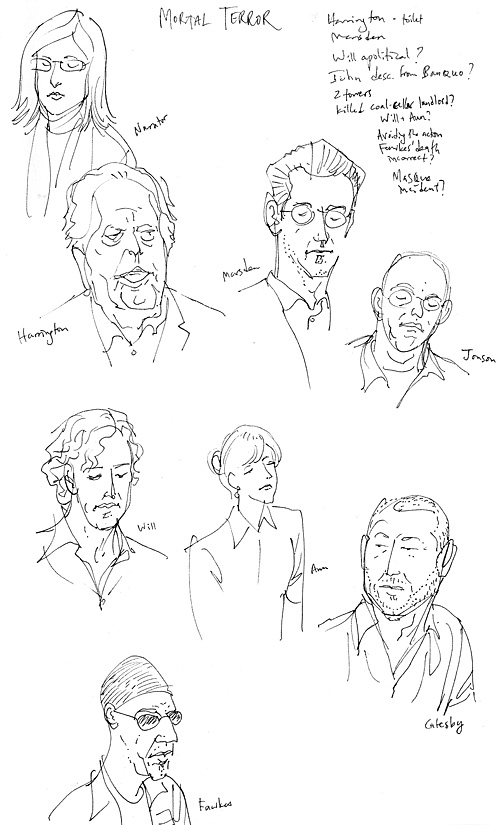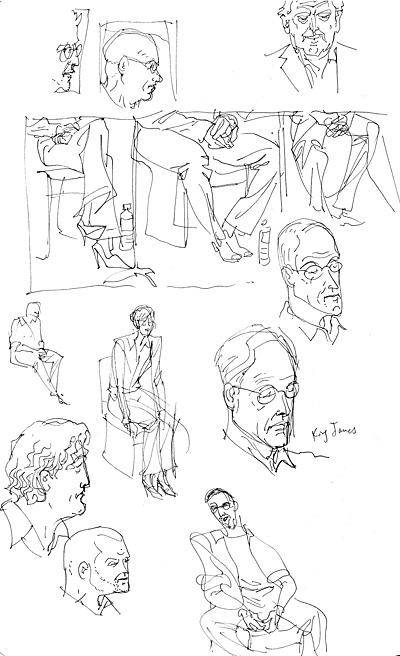Dec 06 2009
Mortal Terror
I have heard absolutely fantastic things about all of the performances that are part of the ART’s “Shakespeare Exploded” festival — http://www.americanrepertorytheater.org/events/festival/shakespeare-exploded — and I am planning to see them all, but events have so far conspired against me. However, I did get to the reading of a new play by Robert Brustein, called Mortal Terror. This is his second play about the life of William Shakespeare, and as I have been seriously contemplating the possibility of writing & drawing a graphic novel on that very topic, I was keen to see what he has done with it. So keen, in fact, that I went out and bought his first play about Shakespeare, The English Channel. I was really hoping for a Q&A afterward, but no such luck.
I suppose I’ll give you a full review of both plays, but put it below the cut for those who don’t care or don’t want spoilers. In the meantime, here are some sketches I did of the (fabulous) actors reading Mortal Terror.


They are: Stafford Clark-Price as Will Shakespeare, John Kuntz as John Marston, Tommy Derrah as Ben Jonson, Jeremy Geidt as Sir John Harrington, Michael Hammond as King James, Merritt Janson as Queen Anne, Ian Kerch as Robert Catesby, and Wesley Savick as Guy Fawkes, with Laura Liberge reading the stage directions.
Apologies if my attempt at a likeness is unflattering to any of these fine actors. I really enjoyed their performances.
First of all, these two plays have titles which are terrible at giving you any sense of what the play is about, but are full of meaning after you’ve read the play.
Second, they are almost non-fiction in terms of their representation of history, but must of necessity be speculative in terms of both dialog and interpretation of historical evidence. For instance, it is generally suspected that King James I was homosexual by inclination, despite having fathered at least 7 children by Queen Anne and having an affair with Anne Murray. This and many other theories about Shakespeare’s England cannot really be proved, so any narrative work about the subject must make assumptions which put it partially into the world of fiction. This is unfortunate, both because it makes such narrative works a rather hard sell (truth being more compelling than invention), and because it means that nonfiction on the topic is rarely readable, as it must be peppered with explanations of the evidence in support and in contradiction of every supposition.
But how are these plays as art? I think the writing is superb. The dialog is mostly in iambic free verse, and does a good job of sounding Elizabethan while being much easier to understand.The characters are interesting and multidimensional. To me, having read about all this stuff, there are times when the facts are interjected a little forcefully, but I doubt this would bother most people. There are a few in-jokes, to be sure, but pretty much everything important is explained adequately for an audience not versed in the history.
I found the male personalities a bit more convincingly real than the female ones, although Queen Anne and the Dark Lady are certainly interesting and highly sympathetic characters. Both plays have wonderful humor and profanity as well as philosophical ruminations on the life of the artist and the destructive impulses of men.
The English Channel is about Shakespeare’s relationships with the intense, brilliant, and openly gay Kit Marlowe, the gorgeous and undiscriminating Earl of Southampton, and the beautiful, feminist, presumed-to-be-the-Dark-Lady-of-the-sonnets Emilia Lanier. It is set in the plague year 1593, and transpires entirely in Shakespeare’s room in the Mermaid Tavern. Events of historical note happen off-stage. The focus is instead on the relationships and the artistic influences.
Mortal Terror takes place 12 years later: 1605, the year of the gunpowder plot. It takes place mostly in the same room at the Mermaid, but adds the palace and its environs so as to bring into the picture the eccentric King James I, who is obsessed with assassins and witches, and Guy Fawkes, who of course tried to blow up Parliament on November 5th. It focuses on the maneuverings of various parties to advance their causes and/or preserve their skins intact, as a deadly plot against the King develops and plays out.There is also speculation about a possible affair between Will and the Queen — interesting! I had a lot of questions afterward, but I guess I’ll have to settle for the answers I can find on the ‘net, for now.
The dialog in these plays is so strong that I would be tempted to use them as a basis for adaptation (if Brustein were willing), except that by focusing almost exclusively on dialog, in limited locations, they exclude nearly all of the actual action. A graphic novel on the same subject would probably take a very different form, as the ability to visualize the events would be a big part of its raison d’etre.
I will report again when I have seen The Donkey Show, Sleep No More, and Best of Both Worlds.
One Response to “Mortal Terror”
[…] the end) of a program they call “Shakespeare Exploded.” I previously blogged about the reading of Robert Brustein’s play Mortal Terror, but that reading series is the sideline to the three main shows, which are: The Donkey Show, a […]